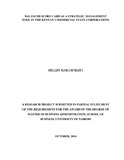| dc.description.abstract | The Balanced Scorecard (BSC) came to the fore following drawbacks from using financial measures only to measure company performance. Managers are using BSC to communicate their strategy, for planning and controlling, for getting feedback and, for performance monitoring. The balanced scorecard complements financial measures of past performance with measures of the drivers of future performance. It provides executives with comprehensive framework that translates a company‟s vision and strategy into a coherent set of performance measures. Against the background of economic growth that started form an all time low of – 0.3 % GDP in 2001, Kenya has been experiencing positive growth rate that is still not good enough especially with its ambitious vision 2030. At its current economic growth there is still need for boosted strategies to achieve sustained growth of 10%. One of the factors that are and have a great potential to facilitate growth will be the Commercial State Corporations. The general objective of the study was to determine how balanced score card is used and adds value as a strategic management tool in Kenyan Commercial State Corporations. The research design that was used in this study is a cross-sectional survey. The main focus of this study was quantitative. However some qualitative approach was used in order to gain a better understanding and possibly enable a better and more insightful interpretation of the results from the quantitative study. The target population of this study consisted of all the Kenyan Commercial State Corporations. According to GoK (2011), there are 31 Commercial State Corporations. The study targeted the executive directors and senior managers of these corporations. The study heavily relied on primary data which was collected through administering structured questionnaire comprising of closed and open-ended questions; developed in line with the objectives of the study. Descriptive statistics technique was used to analyze the quantitative data. The study concluded that Kenyan commercial state corporations implemented the BSC because they wanted to have a system that could be used within all departments, in order to get an overview and a better control of what is happening within the organization. The drawbacks associated with the BSC can be seen as the difficulty with the framework is to balance all four perspectives and know which variable (of information) should be included in which perspective. The study recommended that in order for the BSC to be effective, all levels of an organization must be aware of the problems that initially caused the tool to be applied, and then identify their performance goals as solutions to a problem, and not simply management interference or intrusion. The degree to which the BSC will succeed is in direct proportion to the cooperation of the staff, and the extent to which they interpret their goals. The rationale of adopting the BSC is the recognition of the rhetorical and symbolic effectiveness of the use of the BSC in controlling identities, outdistancing the criticisms of logical weaknesses and weak validity, rhetorical persuasion and instrumental-thinking stimulus. In addition, the review of the BSC measures highlights that identity measures are latently embedded in the four perspectives. The effective design of the BSC incorporating identity measures also provides periodic measurement and reporting of performance in order to achieve organizational objectives and interpret evolving identities over time | en_US |

